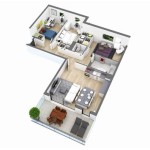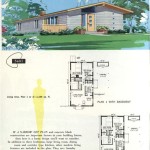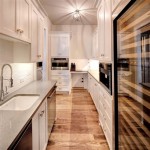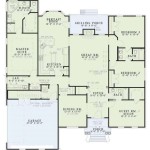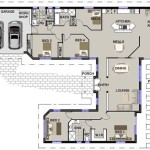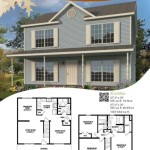1 Bedroom Apartment Floor Plans With Dimensions In Meters Free
A one-bedroom apartment provides a practical living solution for individuals, couples, or those seeking a more manageable living space. Understanding the floor plan and dimensions is crucial in determining if the apartment meets specific needs and preferences. This article explores various one-bedroom apartment layouts, focusing on dimensions in meters, and provides insights into optimizing the space for functionality and comfort. The information presented aims to assist prospective tenants or buyers in visualizing and evaluating the potential of different floor plans, all of which are readily available and free to access.
One-bedroom apartments are diverse in their design, encompassing a range of layouts from linear and open-concept to more compartmentalized structures. Each design offers distinctive advantages and considerations regarding furniture placement, traffic flow, and overall living experience. Accessing floor plans with accurate dimensions in meters allows for precise space planning and helps avoid costly mistakes when furnishing and decorating the apartment. The discussion will explore the key areas of a one-bedroom apartment, providing dimensional context and design considerations for each.
Key Considerations for One-Bedroom Apartment Floor Plans
Before diving into specific floor plans, it is essential to understand key considerations that influence the suitability of a one-bedroom apartment for individual needs. These include the overall square footage, the layout of the living area, the size and configuration of the kitchen, the dimensions of the bedroom, and the bathroom's accessibility and functionality. Furthermore, storage space, natural light, and the presence of outdoor areas such as balconies or patios significantly impact the livability of the apartment.
Square footage dictates the overall feeling of spaciousness. A smaller apartment, perhaps 30-40 square meters, necessitates careful planning and multi-functional furniture. Larger apartments, ranging from 50-70 square meters or more, offer greater flexibility in terms of furniture arrangement and potentially accommodate a small home office or dining area. The layout should facilitate ease of movement and prevent a cramped or cluttered atmosphere. The kitchen should offer sufficient counter space and storage for meal preparation, while the bedroom should comfortably accommodate a bed and wardrobe. Ample storage solutions, either built-in or freestanding, are crucial for maintaining a tidy and organized living environment. Larger windows maximize natural light, creating a brighter and more inviting space. Balconies or patios extend the living area and offer opportunities for outdoor relaxation.
The availability of free floor plans provides a valuable resource for assessing these factors. Online resources often offer a variety of floor plan options, allowing individuals to compare different layouts and identify the best fit for their lifestyle. Accessing these resources enables a more informed decision-making process when searching for a one-bedroom apartment.
Considerations extend to the accessibility of the apartment. Some floor plans feature a direct entry into the living area, while others may have a small foyer or hallway. The positioning of the bathroom relative to the bedroom and living area is also important. A well-designed floor plan prioritizes privacy and ensures convenient access to essential facilities.
Common One-Bedroom Apartment Layouts and Dimensions
Several common layouts characterize one-bedroom apartments. The linear layout, also known as a railroad apartment, features rooms arranged in a straight line, often with the entrance leading directly into the living room, followed by the kitchen, bathroom, and bedroom. This layout can be efficient in maximizing space, but it may lack privacy and natural light in the bedroom if it is positioned at the rear of the apartment.
Open-concept layouts combine the living room, dining area, and kitchen into a single, flowing space. This design promotes a sense of spaciousness and allows for greater flexibility in furniture arrangement. However, it may require strategic zoning to delineate different areas visually. The bedroom is typically separated from the main living area by a wall and door, providing privacy and sound insulation.
Another common layout features a more traditional arrangement with separate rooms for the living room, kitchen, bedroom, and bathroom. This layout offers greater privacy and sound isolation but may feel more confined than an open-concept design. The kitchen may be enclosed or partially open to the living room, depending on the specific floor plan.
In terms of dimensions, the living room in a one-bedroom apartment typically ranges from 12 to 20 square meters. A standard living room might measure 4 meters by 3 meters, providing ample space for a sofa, coffee table, and entertainment unit. Kitchens vary in size depending on the layout. A small kitchenette may be only 4-6 square meters, while a larger kitchen could be 8-10 square meters or more. Bedrooms typically range from 8 to 15 square meters. A bedroom measuring 3 meters by 4 meters provides sufficient space for a double bed, bedside tables, and a wardrobe. Bathrooms are usually the smallest room in the apartment, typically ranging from 3 to 5 square meters.
The precise dimensions will vary depending on the overall size and design of the apartment. Reviewing floor plans with labeled dimensions is crucial for assessing the suitability of a particular layout. Free online resources often provide these floor plans, allowing individuals to compare different options and make informed decisions.
Consider the inclusion of architectural features, such as alcoves, bay windows, or built-in storage, which can significantly impact the usable floor space and overall aesthetics. These features should be carefully considered when evaluating a one-bedroom apartment.
Optimizing Space in a One-Bedroom Apartment
Regardless of the layout or dimensions, optimizing space is essential for comfortable living in a one-bedroom apartment. Multi-functional furniture, such as sofa beds, storage ottomans, and foldable tables, can maximize the use of available space. Vertical storage solutions, such as bookshelves and wall-mounted cabinets, can free up floor space and provide ample storage for belongings.
Strategic use of color and lighting can also enhance the feeling of spaciousness. Light colors and reflective surfaces can make a room appear larger and brighter. Mirrors can create the illusion of depth and expand the visual boundaries of the space. Natural light is highly desirable, so maximize window coverage and avoid heavy curtains that block sunlight.
Maintaining a clutter-free environment is crucial for optimizing space. Regularly decluttering and organizing belongings can prevent the apartment from feeling cramped and overwhelming. Smart storage solutions, such as under-bed storage and wardrobe organizers, can help keep belongings organized and out of sight.
Consider the use of room dividers to delineate different areas within the apartment. A bookshelf, screen, or curtain can effectively separate the living room from the bedroom or create a dedicated workspace. These dividers can add visual interest to the space while providing privacy and functionality.
The integration of technology can also contribute to space optimization. Smart home devices, such as voice-activated lighting and automated blinds, can streamline daily routines and minimize the need for physical switches and controls. Wireless speakers and streaming devices can eliminate the need for bulky audio equipment.
By carefully considering the floor plan, dimensions, and optimization strategies, individuals can transform a one-bedroom apartment into a comfortable and functional living space. Accessing free floor plans with dimensions in meters provides a valuable starting point for this process, allowing for informed decision-making and effective space planning.
Free resources can be found online often offered by real estate agencies, apartment listing services, or architectural design websites. These free floor plans can be invaluable tools for visualizing possibilities and arranging furnishings. By analyzing various different free floor plans tenants can also get a sense of the typical dimensions of specific features, which may then inform their expectations when entering new agreements.
Ultimately, the ideal one-bedroom apartment floor plan depends on individual needs and preferences. By carefully evaluating different layouts and dimensions, individuals can find a space that suits their lifestyle and provides a comfortable and enjoyable living environment.

1 Bedroom Apartment Plan Examples

1 Bedroom Apartment Floor Plans With Dimensions Hd Png Kindpng

1 Bedroom House Plan Examples

40 Small House Images Designs With Free Floor Plans Lay Out And Estimated Cost

1 Bedroom House Plan Room Nethouseplans
Free House Plans Blueprints Civiconcepts

1 Bedroom House Plan Examples

12 Examples Of Floor Plans With Dimensions
Free House Plans Blueprints Civiconcepts

Custom 638 75 Sq Ft Tiny House Plan 1 Bedroom Bathroom With Free Cad File
Related Posts

